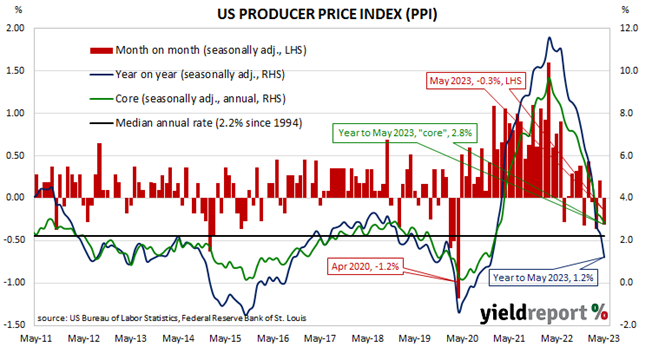Summary: US producer price index (PPI) down 0.3% in May, less than expected; annual rate slows to 1.2%; “core” PPI up 0.2%; NAB: further evidence of building disinflationary forces; short-term Treasury yields up, longer-term yields down; 2024 rate-cut expectations soften; goods prices down 1.6%, services prices up 0.2%.
Around the end of 2018, the annual inflation rate of the US producer price index (PPI) began a downtrend which continued through 2019. Months in which producer prices increased suggested the trend may have been coming to an end, only for it to continue, culminating in a plunge in April 2020. Figures returned to “normal” towards the end of that year but annual rates through 2021 and 2022 were well above the long-term average.
The latest figures published by the Bureau of Labor Statistics indicate producer prices decreased by 0.3% after seasonal adjustments in May. The result was less than the 0.1% fall which had been generally expected and in contrast with April’s 0.2% rise. On a 12-month basis, the rate of producer price inflation after seasonal adjustments and revisions slowed from 2.3% in April to 1.2%.
Producer prices excluding foods and energy, or “core” PPI, increased by 0.2% after seasonal adjustments. The result was in line with the expectations as well as April’s increase and the annual rate slowed from April’s figure of 3.2% to 2.8%.
NAB’s Head of FX Strategy within its FICC division described the figures as “further evidence of building disinflationary forces.” He also noted “core PPI has fallen in twelve of the last thirteen months, from a peak of 9.7% last March to 2.8% in May.”
Shorter-term US Treasury bond yields rose moderately on the day while longer-term yields fell. By the close of business, the 2-year Treasury yield had added 3bps to 4.71%, the 10-year yield had lost 4bps to 3.79% while the 30-year yield finished 3bps lower at 3.90%.
In terms of US Fed policy, expectations of a lower federal funds rate in 2024 softened. At the close of business, contracts implied the effective federal funds rate would average 5.11% in July, 3bps more than the current spot rate, and then increase to an average of 5.24% in August. September futures contracts implied a 5.255% average effective federal funds rate while June 2024 contracts implied 4.625%, 46bps less than the current rate.
The BLS stated higher prices for final demand goods fell by 1.6% on average. Prices of final demand services increased by 0.2%.
The producer price index is a measure of prices received by producers for domestically produced goods, services and construction. It is put together in a fashion similar to the consumer price index (CPI) except it measures prices received from the producer’s perspective rather than from the perspective of a retailer or a consumer. It is another one of the various measures of inflation tracked by the US Fed, along with core personal consumption expenditure (PCE) price data.


